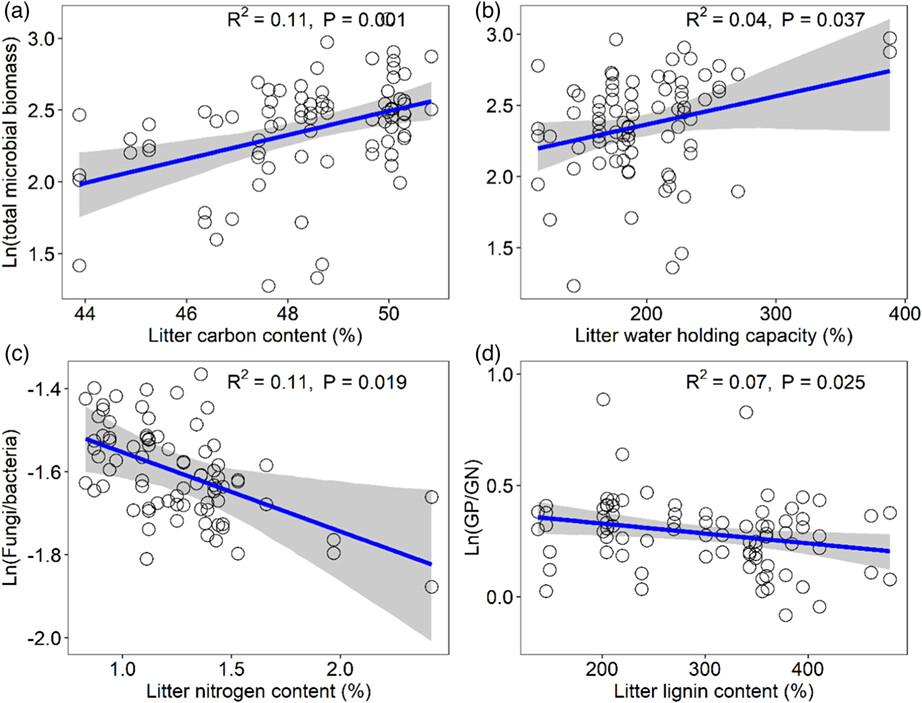Litter and root traits control soil microbial composition and enzyme activities in 28 common subtropical tree species
IF 5.3
1区 环境科学与生态学
Q1 ECOLOGY
引用次数: 2
Abstract
树种与土壤微生物群落之间的相互作用是维持生态系统多种功能的关键。以往关于植物群落与地下生态系统过程的关系研究大多利用叶片功能性状来解释,但是在森林生态系统里面,很多学者发现叶片功能特征与土壤微生物群落组成之间的联系较弱。由于根系和凋落物直接与土壤微生物接触,因此研究根系和凋落物特征如何驱动微生物组成与功能变化对于理解树种与生态系统功能之间的生态联系具有重要的意义。2019年3月我们在中国的南亚热带地区建立了一个树种多样性与生态系统功能野外实验,选择其中的28个树种纯林,我们测定了15个植物功能性状:叶片碳、叶片氮、比叶面积、叶干物质含量、凋落叶碳、凋落叶氮、凋落叶木质素、纤维素、浓缩单宁含量、凋落叶pH值,凋落叶最大持水率、细根碳、细根氮、细根直径和比根长。采用磷脂脂肪酸方法测定土壤微生物生物量和群落组成,同时分析与碳、氮、磷降解有关的5种酶活性。研究结果发现,凋落叶碳含量、最大持水率和根系氮含量是解释土壤微生物群落组成和酶活性变化的重要因子。土壤总的微生物生物量随着凋落叶碳含量、最大持水率的增加而增加;资源开发型树种根系氮含量较高,其微生物群落具有较低的真细菌比和较低的氮、磷降解酶活性;凋落叶持水能力高的树种,其土壤微生物碳、磷降解酶活性较高。我们的研究揭示了根系和凋落物功能特性对于理解植物群落与地下微生物群落组成和功能的生态联系具有重要意义。这一发现对于改进植物群落变化的生态系统功能预测至关重要。

28种常见亚热带树种凋落物和根系性状控制土壤微生物组成和酶活性
树种与土壤微生物群落之间的相互作用是维持生态系统多种功能的关键。以往关于植物群落与地下生态系统过程的关系研究大多利用叶片功能性状来解释,但是在森林生态系统里面,很多学者发现叶片功能特征与土壤微生物群落组成之间的联系较弱。由于根系和凋落物直接与土壤微生物接触,因此研究根系和凋落物特征如何驱动微生物组成与功能变化对于理解树种与生态系统功能之间的生态联系具有重要的意义。2019年3月我们在中国的南亚热带地区建立了一个树种多样性与生态系统功能野外实验,选择其中的28个树种纯林,我们测定了15个植物功能性状:叶片碳、叶片氮、比叶面积、叶干物质含量、凋落叶碳、凋落叶氮、凋落叶木质素、纤维素、浓缩单宁含量、凋落叶pH值,凋落叶最大持水率、细根碳、细根氮、细根直径和比根长。采用磷脂脂肪酸方法测定土壤微生物生物量和群落组成,同时分析与碳、氮、磷降解有关的5种酶活性。研究结果发现,凋落叶碳含量、最大持水率和根系氮含量是解释土壤微生物群落组成和酶活性变化的重要因子。土壤总的微生物生物量随着凋落叶碳含量、最大持水率的增加而增加;资源开发型树种根系氮含量较高,其微生物群落具有较低的真细菌比和较低的氮、磷降解酶活性;凋落叶持水能力高的树种,其土壤微生物碳、磷降解酶活性较高。我们的研究揭示了根系和凋落物功能特性对于理解植物群落与地下微生物群落组成和功能的生态联系具有重要意义。这一发现对于改进植物群落变化的生态系统功能预测至关重要。
本文章由计算机程序翻译,如有差异,请以英文原文为准。
求助全文
约1分钟内获得全文
求助全文
来源期刊

Journal of Ecology
环境科学-生态学
CiteScore
10.90
自引率
5.50%
发文量
207
审稿时长
3.0 months
期刊介绍:
Journal of Ecology publishes original research papers on all aspects of the ecology of plants (including algae), in both aquatic and terrestrial ecosystems. We do not publish papers concerned solely with cultivated plants and agricultural ecosystems. Studies of plant communities, populations or individual species are accepted, as well as studies of the interactions between plants and animals, fungi or bacteria, providing they focus on the ecology of the plants.
We aim to bring important work using any ecological approach (including molecular techniques) to a wide international audience and therefore only publish papers with strong and ecological messages that advance our understanding of ecological principles.
 求助内容:
求助内容: 应助结果提醒方式:
应助结果提醒方式:


